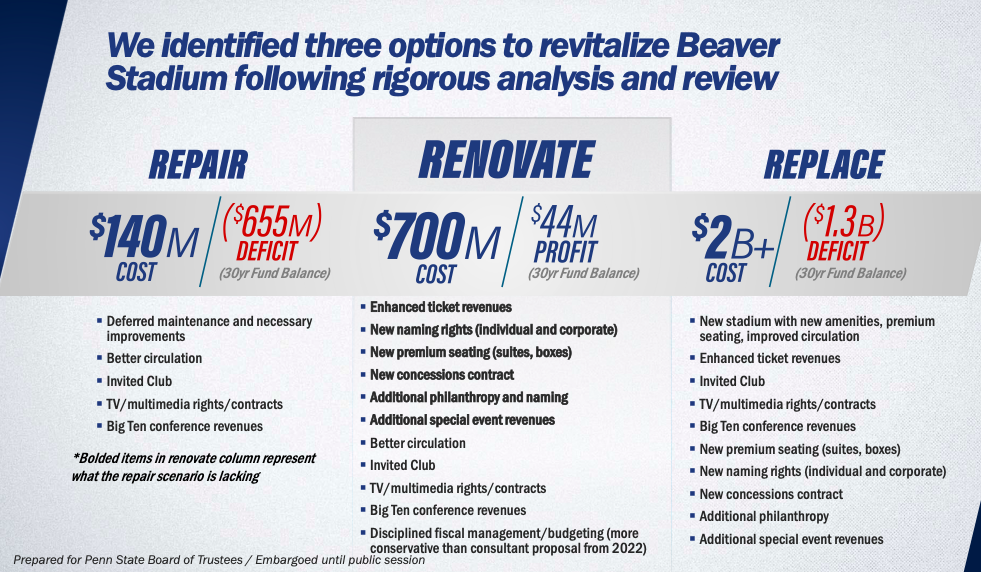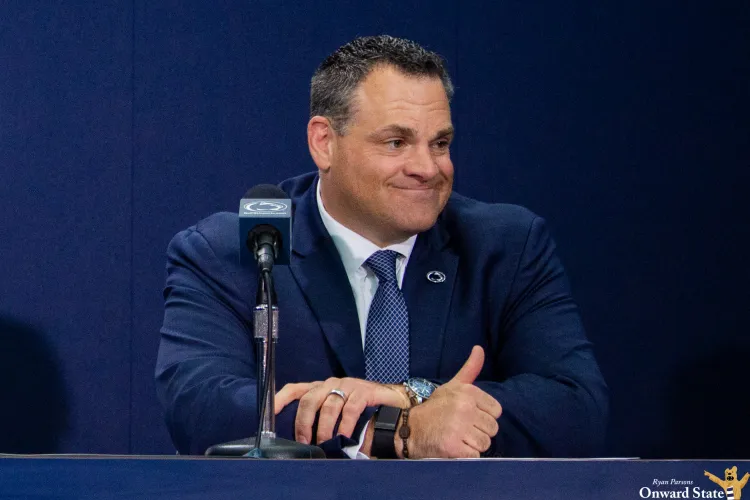Penn State officials are confident that Beaver Stadium’s ongoing, and now fully approved, $700 million renovation project is a sustainable financial model for the athletic department both now and in the future. The expected budget according to Penn State athletics is $664 million. The athletic department would be required to return to the board for approval of anything that would bring the cost of the project above $700 million.
“We looked at three different scenarios,” Sara Thorndike, Penn State senior vice president for finance and business/treasurer, told StateCollege.com on Tuesday. “We looked at just repairing the stadium, because there is [several] 100 million dollars worth of repairs that are immediately needed to be done to the stadium. The only way we really can fund those is with new incremental revenues. Repairing the stadium itself does not generate that new revenue. So it was critical that we ended up adding additional amenities and premium seats in order to generate new revenues to pay back any any debt that we would create.
“We also looked at just completely replacing the stadium. But that was extremely expensive and it would likely be a smaller stadium, which is not what we wanted, and the debt would exceed the revenues it would generate. So $700 million covered the significant maintenance that we needed and it generated enough new incremental revenues to create a financial sustainable model for us to pay it back.”

Several trustees, including Barry Fenchak, who issued an analysis on his website, have said that while renovations are needed, the $700 million pricetag is not affordable and will create too much debt.
Thorndike reiterated that the renovation project will not use tuition dollars and will include a debt servicing plan, although she said that debt will be issued only as needed over the next three years and the department does not project the debt servicing to last the 30-year term of the loans, with generated revenues, philanthropy and naming opportunities anticipated sources of paying down borrowing at a faster rate.
Penn State’s Board of Trustees voted on Tuesday morning to approve the complete funding of the project. A year ago the board had approved an initial expenditure of $70 million which covered a variety of smaller upgrades, including winterization of the stadium, in addition to various planning and construction management costs. Tuesday’s vote, although not unanimous, marked a full-steam ahead moment for a project slated to be completed by August of 2027.
The last major renovation of Beaver Stadium was completed in 2001. It featured the addition of suites on the east side of the stadium and the addition of the upper deck seating areas in the south end of the stadium.
“What we’re going to do is we’re going to make sure that Beaver Stadium is is around for a long, long time,” Penn State Vice President for Intercollegiate Athletics Pat Kraft told StateCollege.com. “What I love about Beaver Stadium, I love the connections that people make, the stories I hear. And so I think if you really look at it, we’re going to fix the things that need to be fixed and it’s going to be a critical piece to the growth and sustainability of our department. But I think it’s going to continue to be a beacon for State College and Penn State University.”
According to an annual report released by the department in January, Penn State athletics operated with roughly $202.2 million in revenues and $202.07 million in expenses for the most recently completed 2022-23 fiscal year. Revenues rose by nearly $21 million while expenses ballooned by $31.5 million. The net budgetary difference of $126,352 marks a significantly smaller margin than the previous fiscal year, which saw Penn State athletics report $10.6 million less in expenses than its $181.2 million revenue total. Both fiscal years mark a positive cash flow following the COVID-19 pandemic.
While a second generational pandemic seems unlikely, changes in the current college athletics model, including revenue sharing on an annual basis — a figure that could run upwards of $20 million annually according to reports — could significantly impact the budgetary arithmetic for athletic departments across the country, let alone ones undertaking $700 million renovation projects and debt servicing. Thorndike is confident that those changes, foreseen or otherwise, are manageable budgetary obstacles.
“I feel like we have stress tested multiple scenarios extensively with new revenues that are coming in to athletics even outside of the stadium but also the new incremental revenues that will be generated by the stadium,” Thorndike added. “We feel very confident that athletics has the funding with a stadium of our size and our caliber of programs to fund this, I’m not concerned.”
“So when we’re creating a financial performance for 30 years, we tried to consider every expense that we might incur during that time and we know that athletics is changing rapidly. So we have a cost put into the pro forma with the assumptions based on information that we have, and intentionally was more conservative just to make sure we’d have enough to cover things like revenue sharing for players.”
Like everyone looking to tackle long term, major financial undertakings, Penn State will hope that its projections and assumptions are correct. Something that only the passage of time will uncover.
Stay tuned for more coverage.



